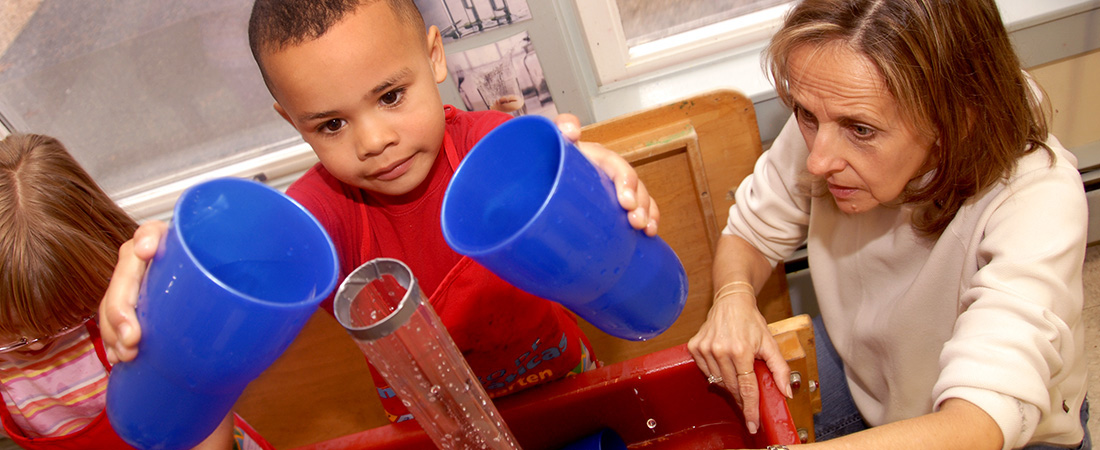Working Together to Help the Youngest

Young children benefit from expanded high-quality learning experiences.
EDC's Diane Schilder has authored two research snapshots detailing different aspects of child-care and Head Start partnerships:
- What the Research Says About Financial Arrangements and Resources
- What the Research Says About Establishing and Sustaining Partnerships
More information about partnerships is also available from the Office of Early Childhood Development.
Research continues to show that by the time children from low-income families enter school, they are already behind their more affluent peers. And as academic stakes get higher for all grades, expanding high-quality, early learning opportunities for children from low-income families becomes increasingly important.
Combining Head Start services with private child-care providers is one promising option for closing this gap. Earlier this year, Congress supported this movement by authorizing $500 million for a new Early Head Start-Child Care Partnership initiative, which helps fund the integration of these traditionally separate programs in the name of giving more kids a better chance at success.
EDC researcher Diane Schilder says that this initiative is an important first step toward improving the way that early childhood programs serve children—and their parents. Schilder recently served on the program committee for Head Start’s 12th National Research Conference on Early Childhood.
Q: What does an environment that blends Head Start and traditional childcare look like?
Schilder: Imagine a regular child-care center that offers services from 7 a.m. to 7 p.m. Now you add a Head Start component. What changes? Teachers receive better professional development because Head Start requires staff to have a professional development plan. And thanks to Head Start’s rigorous standards for language development, students potentially receive more vocabulary-rich services. There is also more support and access to educational screenings, which can help educators identify learning disabilities early on.
So not only does this partnership broaden access for families who qualify for Head Start, but it also increases the levels of service for all children.
Q: How does this blended approach help young children and their families?
Schilder: The need for childcare often presents working, low-income parents and guardians with a dilemma: choose between high-quality Head Start programs, which may only be half-day, or full-day childcare. While some quality child-care centers operate, research has shown that the average quality is lower—with a less structured curriculum and far fewer health and social services.
Families shouldn’t have to make this choice. Integrating Head Start services with full-day child-care services allows more low-income families to have their coverage needs met in a high-quality educational setting. This is all so important now because academic expectations are increasing, even for entry to kindergarten.
Q: What are the challenges to combining these programs?
Schilder: Alignment among the services can be difficult because each system was designed for very different purposes. Childcare’s main role is to keep kids safe while their parents work. Head Start and Early Head Start have a broader mission to provide comprehensive health, education, and social wellness programming for children from low-income families. It has historically been difficult to align all services into one program that meets families’ needs, in part because the regulations are so different. For example, though childcare is regulated by states, Head Start is regulated by the federal government, and aligning eligibility, quality features, and services requires careful consideration of both state laws and federal requirements.
However, we are learning what it takes to create good partnerships. Agreeing on staff responsibilities is important. So is reaching consensus about a curriculum. Having a plan for financial management is important, too, since partnerships need to monitor both federal and private financial streams. Thankfully, there is also renewed interest in the alignment of services because of the passage of the Early Head Start-Child Care Partnership initiative.
Q: Do you think the idea of partnership will catch on more broadly?
Schilder: I do. There have been conversations about this for decades.
I recently published a paper with EDC’s Ashley Smith Leavell that showed blended programs simply offered better services and language and literacy practices to children than child-care centers operating outside a partnership.
Research has also shown that low-income children who are in settings with higher income children benefit in terms of longer-term educational outcomes. So not only are blended programs more diverse because they can meet the needs of a wider group of families, but this diversity actually helps kids.
People are beginning to recognize that Head Start and child-care centers have unique strengths, and that just because a child is in a family daycare doesn’t mean they can’t have enhanced services. That’s heartening.